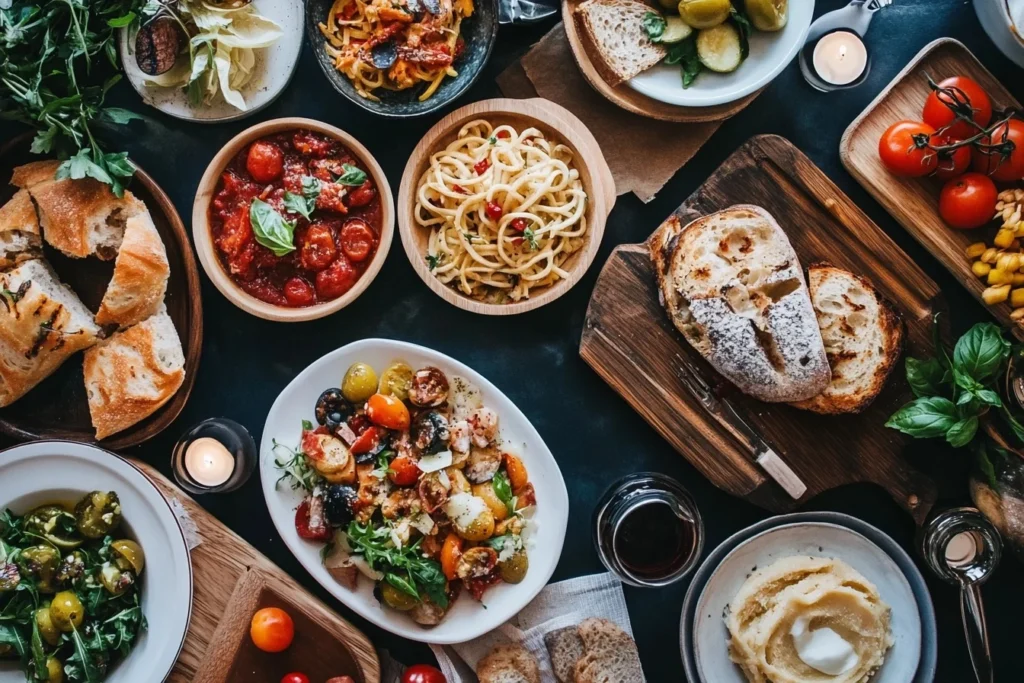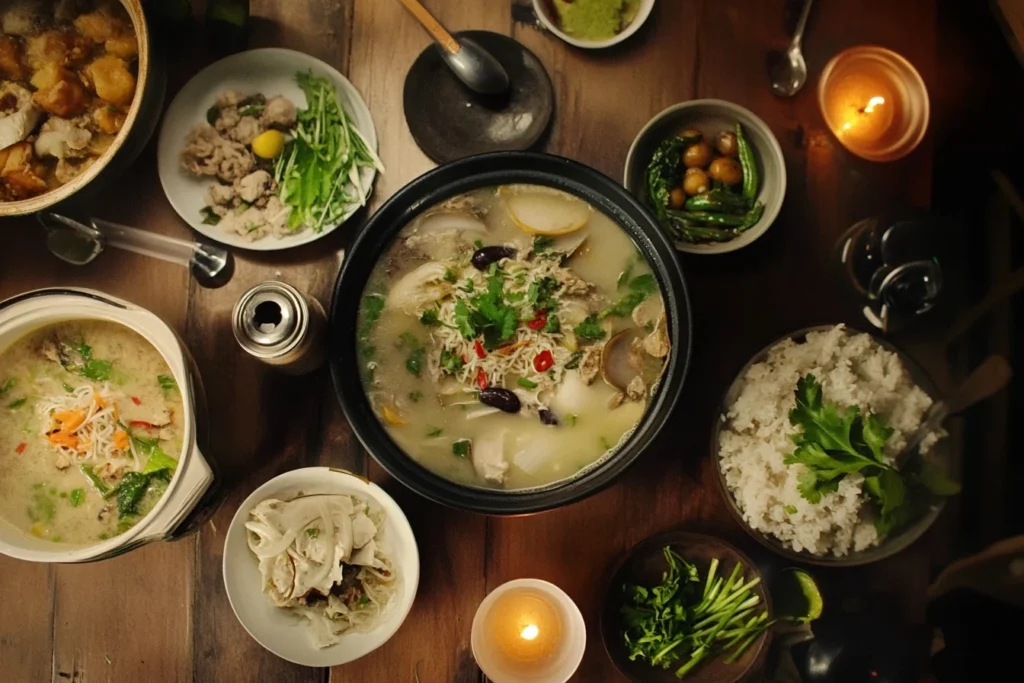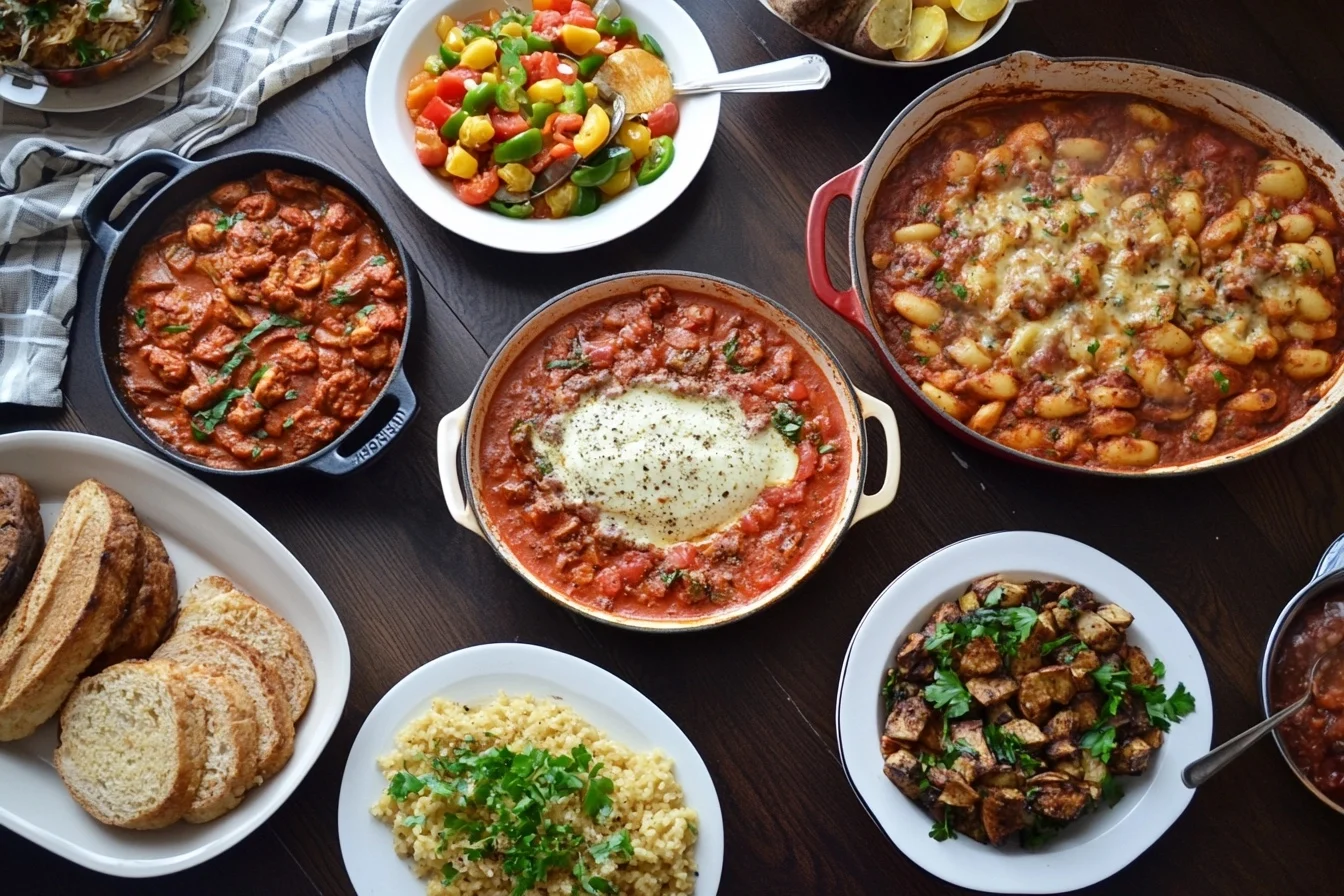Life’s moments often feel richer with the perfect bite of something comforting. Whether it’s a hearty stew on a chilly night or a slice of pie that brings back childhood memories, comfort food holds a special place in our hearts—and stomachs. This article dives deep into what makes comfort food so universally beloved. From its emotional ties to cultural significance, and even some easy-to-make recipes, we’ll explore every aspect of these dishes that nourish both body and soul.
Table of Contents
What Is Comfort Food?
Comfort food is more than just a plate of deliciousness; it’s a feeling, a memory, and a connection. The idea transcends borders and cultures, but it always centers around one thing—making you feel good.
Definition and Characteristics
Comfort food typically refers to dishes that bring a sense of warmth, nostalgia, or emotional relief. These are often simple meals, rich in flavor and steeped in tradition. From mac and cheese to chicken noodle soup, these dishes are known for their ability to soothe and satisfy.
- Warm and Filling: Most comfort foods are hearty, high in carbs, or packed with fats, providing a literal sense of satisfaction.
- Emotionally Resonant: A bite of your grandmother’s lasagna or a bowl of ramen after a long day evokes memories and emotions.
Historical Origins
The concept of comfort food has existed for centuries, even if the term itself only gained popularity in the 20th century. Historically, these foods were tied to survival and sustenance. Hearty stews, for instance, were a staple for laborers, providing energy and warmth in harsh conditions.
In the 1960s, psychologists coined the term “comfort food” to describe the dishes people sought during stress or emotional lows. The connection between food and emotions became a topic of study, further solidifying these meals’ importance in our lives.
Cultural Variations Around the World

Every culture has its own version of comfort food. While fried chicken and mashed potatoes might come to mind in the U.S., other regions turn to their local staples:
- Japan: Ramen, with its rich broth and tender noodles, is a soul-soothing favorite.
- Italy: Think creamy risotto or indulgent lasagna, brimming with layers of cheesy goodness.
- India: Butter chicken and naan, with their warm spices, provide the ultimate cozy meal.
Despite the diversity, the common thread remains: comfort food is deeply personal yet universally understood.
Why We Crave Food
The allure of comfort food runs deeper than just its taste. It satisfies cravings, uplifts spirits, and brings a sense of calm when life feels overwhelming. But why do we turn to these dishes during emotional highs and lows?
Psychological Connection to Food
Ever wonder why eating mac and cheese or a bowl of chili feels like a warm hug? That’s because comfort food is strongly linked to our emotions. It often carries memories of home-cooked meals or happy moments with loved ones.
- Nostalgia: Certain dishes remind us of childhood or special occasions. The smell of freshly baked cookies, for instance, might bring back memories of holidays spent with family.
- Emotional Fulfillment: During stressful times, food can act as a coping mechanism. A study revealed that people often choose familiar meals to reduce feelings of anxiety or sadness.
- If you’re looking for alternative meat options, check out these Ground Elk Recipes: , which can also be a lean and protein-rich choice.
Emotional Triggers and Associations
Comfort food doesn’t just appear out of nowhere—it’s often tied to key moments in our lives. Many people associate specific meals with feelings of safety, joy, or warmth.
- Celebratory Comfort Foods: Birthdays often mean cake, while Thanksgiving is incomplete without turkey and mashed potatoes.
- Seasonal Cravings: In colder months, hot soups and casseroles are favored, while summer may call for sweet ice cream or fruity pies.
The Science Behind Food and Stress
Believe it or not, there’s a scientific reason why comfort food feels so satisfying. High-carb and high-fat meals can temporarily boost serotonin, a chemical that regulates mood.
- Stress Eating: When stressed, the body craves energy-dense foods as a quick source of relief. This is why we often reach for chips, fries, or other indulgent options.
- Brain Connection: Eating these foods activates the brain’s reward system, offering a temporary sense of pleasure.
The connection between food and emotions makes comfort food much more than just a meal—it’s therapy on a plate.
Top Food Dishes Across the Globe
Every corner of the world, without a doubt, has its own unique take on comfort food. Moreover, these dishes beautifully reflect the culture, climate, and traditions of the people who cherish them. So, let’s embark on a flavorful journey around the globe to explore some of the most beloved comfort meals.

Classic American Foods
In the U.S., comfort food is synonymous with hearty, stick-to-your-ribs dishes. These meals are often rich, flavorful, and perfect for sharing.
- Mac and Cheese: Creamy, cheesy, and baked to perfection, this dish is a crowd favorite.
- Fried Chicken: Crispy and golden, this Southern staple brings warmth and joy to the table.
- Pot Roast: A slow-cooked meal loaded with tender meat and root vegetables.
European Comfort Delights
Europeans know a thing or two about comfort. Their dishes are deeply rooted in tradition and often feature simple, wholesome ingredients.
- Italy: Lasagna, with its layers of pasta, cheese, and rich meat sauce, is a true classic.
- France: Coq au vin, a chicken stew with red wine, offers a cozy and refined option.
- Germany: Schnitzel and spaetzle (egg noodles) are hearty favorites that satisfy every craving.
Asian Staples in Comfort Cuisine
Asia’s comfort food is a flavorful mix of spices, broths, and rice-based dishes that warm both body and soul.
- Japan: Ramen, with its rich broth and tender noodles, is the ultimate comfort bowl.
- India: Butter chicken paired with naan creates a perfect balance of spice and creaminess.
- China: Congee, a rice porridge, is often enjoyed as a soothing, warm meal.
South American and African Comfort Dishes
In South America and Africa, comfort food highlights bold flavors and vibrant ingredients.
- Brazil: Feijoada, a black bean stew with pork, is a beloved national dish.
- Ethiopia: Injera, a spongy flatbread served with spicy stews, offers comfort and tradition in every bite.
- Mexico: Enchiladas, loaded with cheese and flavorful sauces, are a popular go-to meal.
Food, undeniably, connects people through taste, tradition, and emotion. For instance, from the creamy pasta of Italy to the spicy curries of India, each dish tells a rich story of culture and comfort. Furthermore, we’ll now explore how these meals take center stage in special occasions and gatherings.
If you’re interested in high-protein recipes, check out this Beef Sausage Recipes for another great source of protein.
The Role of Food in Special Occasions
food is not just about flavor—it’s deeply woven into our celebrations, traditions, and moments of togetherness. From festive holidays to quiet nights of recovery, these meals bring people closer and offer more than just sustenance.
Holiday Traditions
Special occasions often call for signature dishes that define the holiday spirit. food plays a leading role in these celebrations by evoking nostalgia and creating shared joy.
- Thanksgiving Favorites: Turkey, mashed potatoes, and pumpkin pie are more than just food—they’re a symbol of gratitude and family unity.
- Christmas Feasts: Whether it’s a hearty roast, creamy eggnog, or sugar cookies, Christmas meals create lasting memories.
Celebrations and Family Gatherings
Food has a magical way of bringing people together. Comfort foods, in particular, are the highlight of many family gatherings. Birthdays, weddings, and reunions often feature beloved dishes that are simple yet satisfying.
- Birthday Delights: Cakes, especially chocolate or sponge, take center stage at birthday celebrations.
- Potluck Essentials: Dishes like casseroles, chili, and potato salads are common staples at community or family events, showcasing the universal love for comfort food.
Healing Power During Illness and Recovery
When you’re feeling under the weather, comfort food can be just what the doctor ordered. Soups, broths, and teas are gentle on the stomach and packed with nutrients.
- Chicken Noodle Soup: A global go-to for colds, it’s light yet nourishing.
- Rice Porridge: In many cultures, congee or rice porridge is a staple during illness, offering warmth and ease of digestion.
For more delicious recipes that can add a touch of comfort to your next celebration, check out The Ultimate Guide to Bean Soup Recipes.
Easy-to-Make Comfort Food Recipes
Not every comfort meal needs hours in the kitchen. Some of the most heartwarming dishes are quick and simple, perfect for busy days or novice cooks. Let’s dive into some recipes that embody the spirit of comfort food.
Quick and Simple Dishes for Beginners
Sometimes, a satisfying meal is only a few steps away. These recipes are easy to whip up but deliver maximum flavor.
- Grilled Cheese Sandwich: Pairing perfectly toasted bread with melted cheese, it’s a childhood favorite that never gets old.
- Instant Ramen Upgrades: With a few add-ins like eggs, veggies, or chicken, a basic packet of ramen transforms into a comforting masterpiece.
Classic Recipes with Modern Twists
Traditional comfort food recipes are timeless, but a modern twist can elevate their appeal.
- Cauliflower Mac and Cheese: A lighter version of the classic, using cauliflower for extra nutrition without sacrificing taste.
- Tex-Mex Meatloaf: A spiced-up take on traditional meatloaf, featuring jalapeños and a tangy glaze.
One-Pot Meals and Slow-Cooker Options
For those who want convenience without compromising flavor, one-pot and slow-cooker meals are ideal.
- Beef Stew: Packed with tender meat and vegetables, it’s a comforting choice for a busy evening.
- Slow-Cooker Chili: Perfect for game days or lazy weekends, this dish simmers all day to bring out deep, robust flavors.
For more hearty recipes, explore Chicken Pot Pie Recipe
Comfort Food and Health: Myths and Facts
The term often brings to mind rich, calorie-laden dishes. While these meals are celebrated for their indulgence, they don’t always have to be unhealthy. Let’s debunk some common myths and explore ways to enjoy these heartwarming meals guilt-free.

Is Comfort Food Always Unhealthy?
It’s a common belief that comfort food is synonymous with unhealthy eating. However, this isn’t entirely true. While some dishes are high in fats and carbs, others can be nutritious and balanced.
- Myth: All comfort food is loaded with empty calories.
Fact: Many comfort foods, like soups and stews, are packed with vegetables, lean proteins, and healthy fats. - Myth: Comfort food always leads to weight gain.
Fact: Portion control and mindful eating can make even the richest dishes part of a healthy diet.
Balancing Flavor and Nutrition
You don’t need to sacrifice taste to make comfort food healthier. Simple swaps can lighten up your favorite meals while keeping them delicious.
- Substitutions: Use Greek yogurt instead of cream, or whole-grain pasta instead of refined.
- Additions: Incorporate more vegetables into dishes like casseroles or stir-fries for added nutrients and flavor.
- Cooking Methods: Baking or grilling instead of frying can significantly cut down on unhealthy fats.
Healthier Alternatives Without Losing Taste
If you’re looking to enjoy comfort food with a healthier twist, here are some ideas:
- Zucchini Noodles with Meat Sauce: A low-carb take on spaghetti, with all the comforting flavors you love.
- Baked Sweet Potato Fries: A crispy, satisfying alternative to traditional fries.
The Future of Comfort Food
As tastes and priorities evolve, so does the world of comfort food. Modern innovations, dietary trends, and sustainability concerns are reshaping how we define and enjoy these timeless meals.
Trends in Comfort Food Innovations
The demand for plant-based and health-conscious options has revolutionized the comfort food landscape.
- Vegan Comfort Foods: Plant-based mac and cheese, lentil shepherd’s pie, and jackfruit pulled “pork” are gaining popularity.
- Fusion Dishes: Chefs are blending global cuisines to create unique comfort dishes, like kimchi grilled cheese or tikka masala pizza.
Vegan and Plant-Based Comfort Options
Plant-based comfort foods are no longer a niche. These dishes appeal to vegans and omnivores alike by offering bold flavors and satisfying textures.
- Vegan Chili: A hearty mix of beans, vegetables, and spices that rivals traditional recipes.
- Cauliflower Wings: A spicy, crispy alternative to buffalo wings that satisfies the craving without the meat.
Sustainability in Comfort Food Choices
As awareness about the environmental impact of food grows, sustainability has become a priority. Comfort food is no exception.
- Seasonal Ingredients: Using local and seasonal produce not only enhances flavor but also reduces carbon footprints.
- Eco-Friendly Packaging: More takeout-friendly comfort foods are now served in biodegradable or recyclable containers.
FAQs
To wrap up this journey into the world of comfort food, let’s address some of the most frequently asked questions about these beloved dishes. From what makes them so special to how they fit into a healthy lifestyle, here’s everything you need to know.
What Makes a”Comfort Food”?
Comfort food isn’t just about taste—it’s about how it makes you feel. These dishes are deeply tied to emotions, memories, and culture.
Key Characteristics: Comfort food is often warm, filling, and rich in flavor. It typically evokes a sense of nostalgia or provides emotional relief during stressful times.
Personal Connection: What qualifies as comfort food varies from person to person. For some, it’s a bowl of ramen; for others, it might be freshly baked cookies or a hearty lasagna.
Can Comfort Food Be Healthy?
Absolutely! While comfort food is often associated with indulgence, it can also be part of a balanced diet when prepared thoughtfully.
Healthy Tweaks: Swapping ingredients—like using whole grains or reducing added sugars—can make comfort dishes more nutritious without losing their appeal.
Mindful Eating: Enjoying comfort food in moderation allows you to savor the flavors without overindulging.
What Are the Best Comfort Foods for Stress Relief?
Absolutely! While comfort food is often associated with indulgence, it can also be part of a balanced diet when prepared thoughtfully.
Creamy Dishes: Foods like mashed potatoes or mac and cheese provide a soothing texture that many find calming.
Warm Beverages: A cup of hot cocoa or herbal tea can be just as comforting as a meal.
Comfort food has a special way of satisfying both our taste buds and our hearts. It’s more than just a meal—it’s a source of happiness, nostalgia, and connection. Whether you’re enjoying a traditional favorite or exploring a new twist on an old classic, these dishes remind us of the joy found in simple pleasures. After all, sometimes true contentment is just a bite away.

Comfort Food Classic: Creamy Mac and Cheese
- Total Time: 20 minutes
- Yield: 4 bowls of mac and cheese 1x
Description
There’s nothing quite as comforting as a creamy, cheesy bowl of mac and cheese. Perfectly cooked pasta enveloped in a rich cheese sauce, this dish is the ultimate comfort food. Whether you’re seeking nostalgia or a quick meal, this mac and cheese will warm your soul with every bite.
Ingredients
- 2 cups elbow macaroni (or your favorite pasta)
- 2 cups shredded sharp cheddar cheese
- 1 cup milk (whole milk or 2% recommended)
- 2 tablespoons unsalted butter
- 2 tablespoons all-purpose flour
- 1/2 teaspoon garlic powder
- 1/2 teaspoon mustard powder (optional)
- Salt and pepper to taste
- 1/4 teaspoon paprika (for garnish)
Instructions
- Cook the Pasta: In a large pot of boiling salted water, cook the elbow macaroni according to the package instructions, about 8-10 minutes. Drain and set aside.
- Make the Roux: In the same pot, melt butter over medium heat. Add flour and whisk constantly for about 1-2 minutes, until it forms a smooth paste.
- Add Milk: Slowly pour in the milk while continuing to whisk, ensuring the mixture stays smooth. Bring to a simmer and let cook for 2-3 minutes until it thickens.
- Add Cheese: Lower the heat and add the shredded cheddar cheese, garlic powder, mustard powder, salt, and pepper. Stir until the cheese is melted and the sauce is smooth.
- Combine Pasta and Sauce: Add the cooked macaroni to the cheese sauce, stirring gently until well coated.
- Garnish and Serve: Sprinkle with paprika for extra flavor and color, then serve immediately.
Notes
- For an extra crispy topping, bake the mac and cheese in a casserole dish with some extra cheese and breadcrumbs on top for 10 minutes at 350°F.
- Feel free to swap the sharp cheddar for any cheese you prefer, like Gruyère or mozzarella, for a different flavor profile.
- This dish can also be made ahead and stored in the fridge for 1-2 days. Reheat in the microwave or on the stovetop with a splash of milk to restore its creamy consistency.
- Prep Time: 5 minutes
- Cook Time: 15 minutes
- Category: dinner
- Cuisine: American
Nutrition
- Serving Size: 4 servings
- Calories: 450 per serving
- Fat: 22g
- Carbohydrates: 50g
- Protein: 15g
Keywords: Classic mac and cheese recipe, Comfort food mac and cheese


